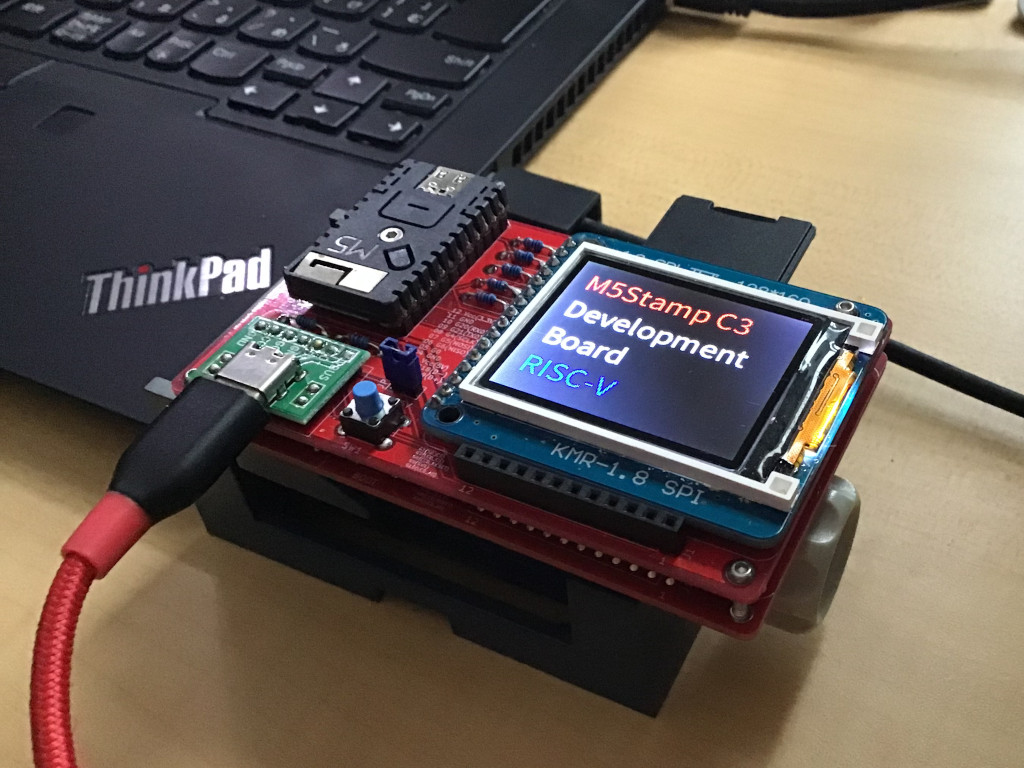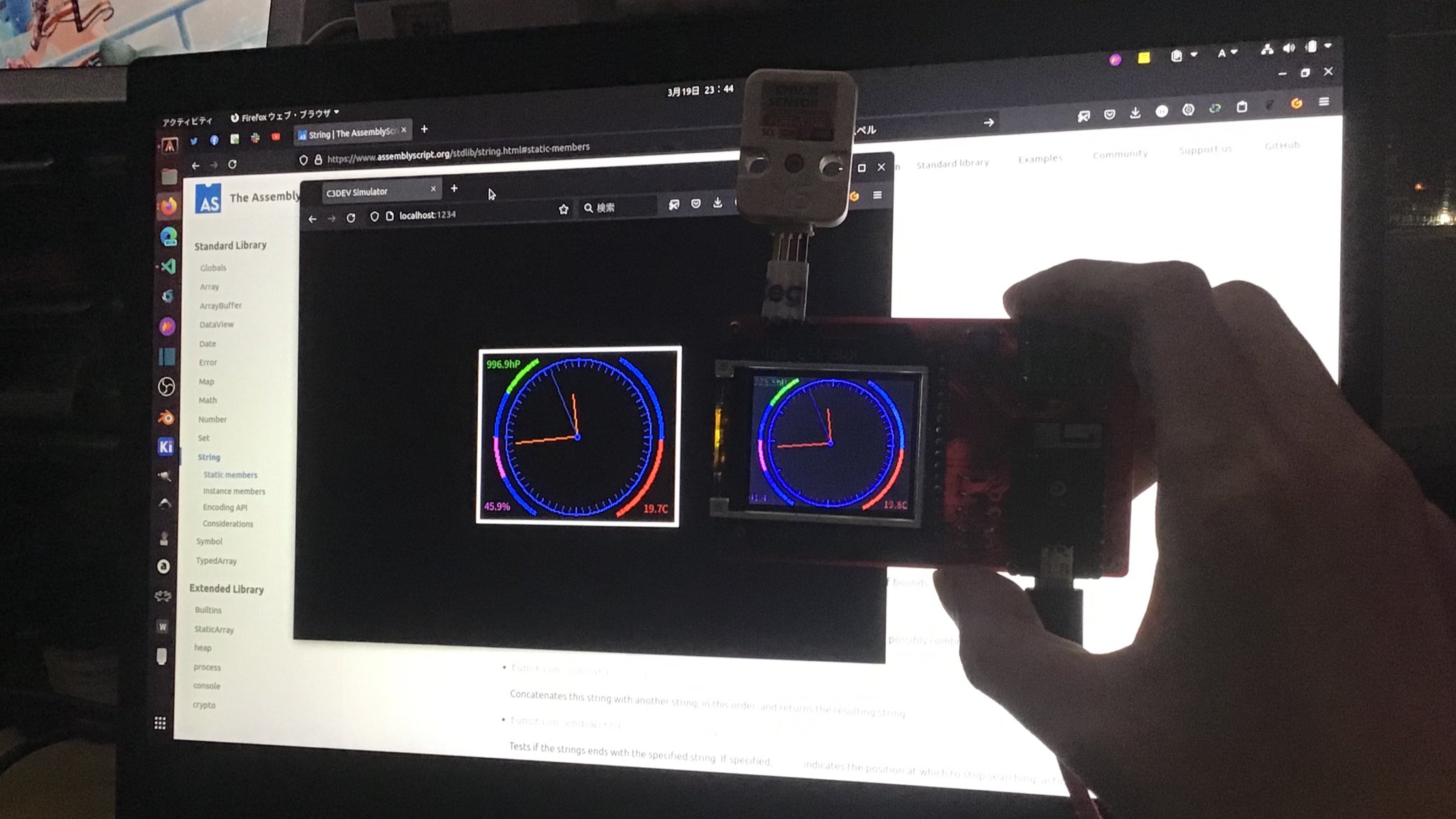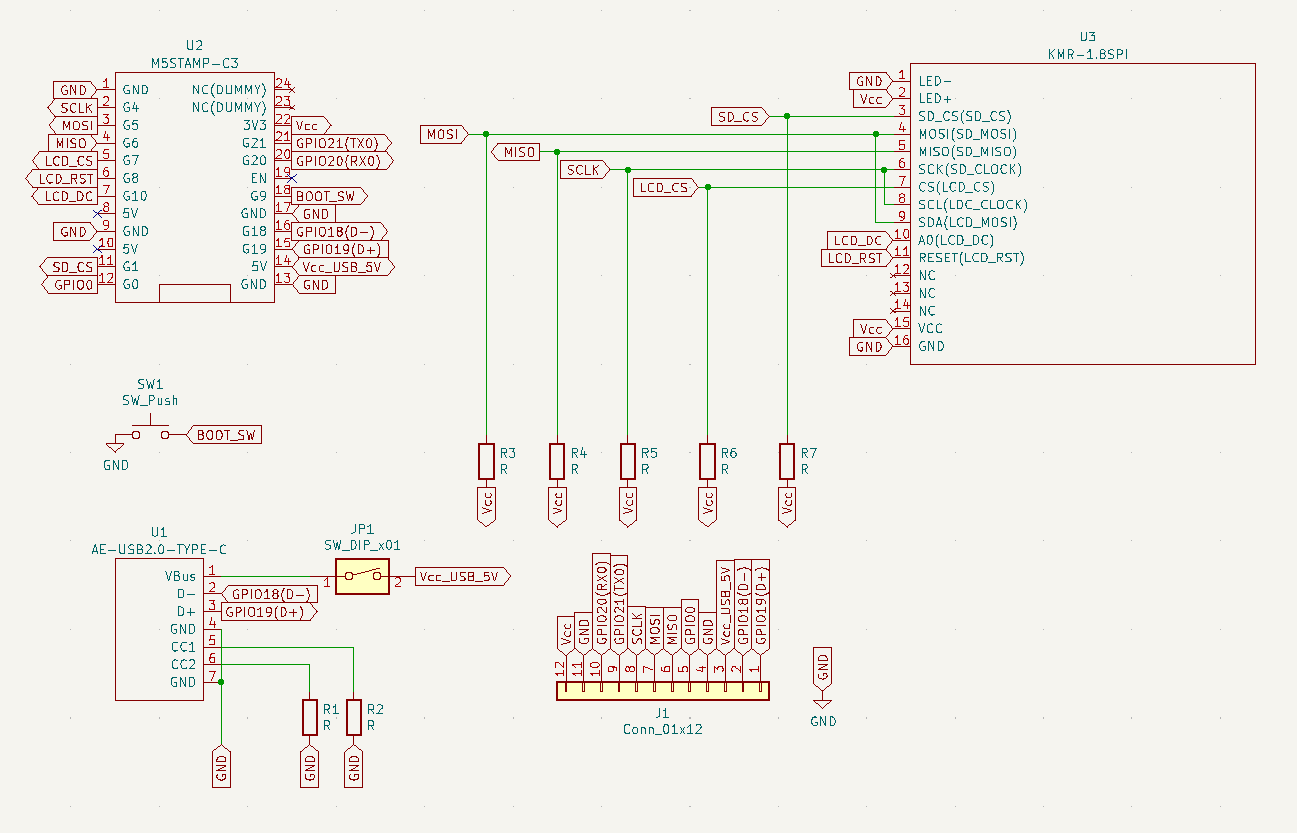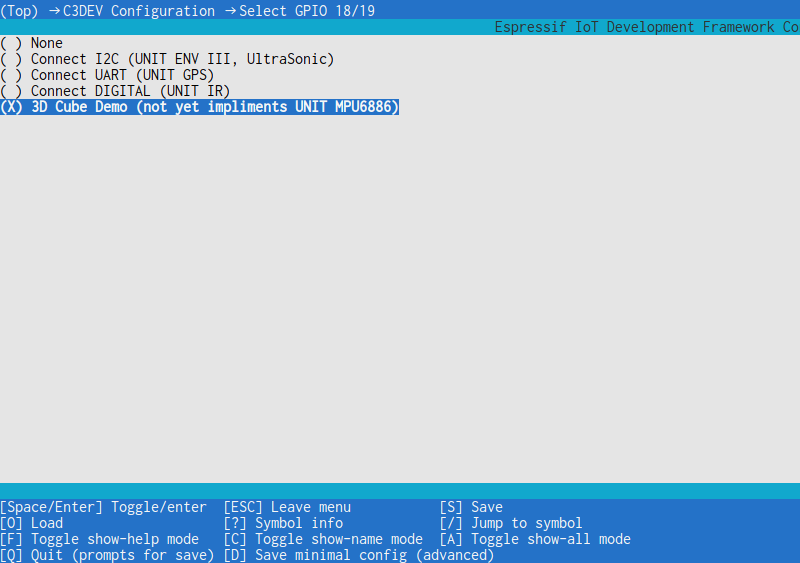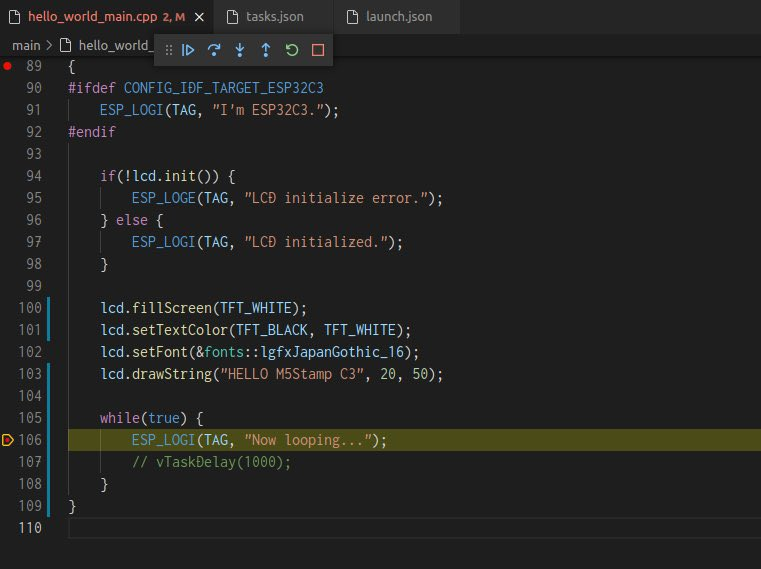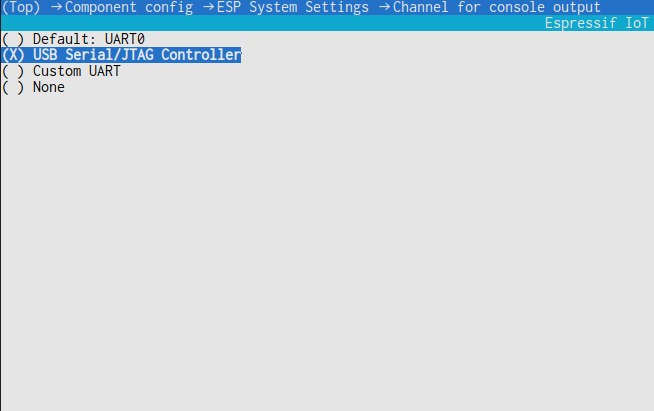This is a development board for the M5Stamp C3 (RISC-V/FreeRTOS).
Hardware
- External USB-C port for JTAG debugging
- Support for LCD panel and SD card
- Selecting a power supply
- Switch(GPIO9) to enter loader mode
- Pin headers to expose usable GPIOs to the outside
- The size is just Japanese business card
Sample Sources Included
- TrueType font with Japanese output to LCD - test_freetype.cpp
- Output PNG images in SD card to LCD - test_tinypng.cpp
- NTP synchronization via WiFi connection - test_nvs_wifi.cpp
- Test ADC on GPIO0
- UNIT Light - main.cpp
- Test I2C on GPIO18, 19
- UNIT ENV III - test_i2c_gpio1819.cpp
- UNIT ULTRASONIC - test_i2c_gpio1819.cpp
- Test UART on GPIO18, 19
- UNIT GPS - test_uart_gpio1819.cpp
- Test DIGITAL on GPIO18, 19
- UNIT IR - test_digit_gpio1819.cpp
- WebAssembly execution with Wasm3
- Analog clock using AssemblyScript - test_wasm3_clockenv.cpp
- GPS GSV viewer using AssemblyScript - test_wasm3_gpsgsv.cpp
- Support RGB LED (SK6812) - main.cpp
- Usage of SPIFFS, which stores TrueType fonts and .wasm binaries (parttool.py and spiffsgen.py tools)
- Use of NVS (cryptographically enabled key value store) that stores WiFi passwords (nvs_partition_gen.py tool)
- Building libraries and managing dependencies using the esp-idf build system
- Visual Studio Code C/C++ Extention configuration and JTAG debugging configuration in conjunction with openocd
- AssembyScript sharing method between web browser and microcontroller - wasm
This repository contains MIT Licensed PCB data and example programs.
| #Unit | Name | Note | Where to get it |
|---|---|---|---|
| U1 | AE-USB2.0-TYPE-C | USB 2.0 Type-C Break out board | akizukidenshi.com (JP) |
| U2 | M5STAMP-C3 | M5Stamp C3 | + M5Stack + SWITCH SCIENCE (JP) |
| U3 | KMR-1.8SPI | KMR-1.8 SPI marked LCD and SD card interface | + amazon.co.jp (1) + ja.aliexpress.com |
| R1 - R2 | 5.2K Resistor | Pull-down for USB Power supply | - |
| R3 - R7 | 10K Resistor | SPI pull-up | - |
| JP1 | Jumper pin | Select external power supply | akizukidenshi.com (JP) |
| SW1 | Tact switch | for loader mode and utility | akizukidenshi.com (JP) |
| J1 | 12 Pin header | You can use the one that comes with the M5Stamp C3 Mate | - |
get_idf or (Windows) ESP-IDF 4.4.2 command prompt
# Linux or macOS ->
$ alias get_idf='. $HOME/esp/esp-idf/export.sh'
$ get_idf
# <-
Detecting the Python interpreter
... snip ...
Done! You can now compile ESP-IDF projects.
Go to the project directory and run:
idf.py build
$ echo ${IDF_PATH}
/home/hiromasa/devel/toolchain/esp/esp-idf
$ riscv32-esp-elf-gcc -v
Using built-in specs.
COLLECT_GCC=riscv32-esp-elf-gcc
... snip ...
gcc version 8.4.0 (crosstool-NG esp-2021r2)
openocd (Optional)
$ openocd
Open On-Chip Debugger v0.10.0-esp32-20211111 (2021-11-10-21:40)
Licensed under GNU GPL v2
For bug reports, read
http://openocd.org/doc/doxygen/bugs.html
git clone and build
git clone --recursive https://github.com/h1romas4/m5stamp-c3dev
cd m5stamp-c3dev
idf.py build flash
Note: If you get a compile error, change the sdkconfig back to the Git one. In some cases, the target of sdkconfig is changed to esp32 instead of eps32c3.
Write TypeType font to SPIFFS
parttool.py write_partition --partition-name=font --partition-subtype=spiffs --input resources/spiffs_font.bin
Write WebAssembly(.wasm) to SPIFFS
parttool.py write_partition --partition-name=wasm --partition-subtype=spiffs --input resources/spiffs_wasm.bin
Setup WiFi (Optional)
- Change WiFi Setting
nvs_partition.csv: Set own [ssid], [password]
key,type,encoding,value
wifi,namespace,,
ssid,data,string,[ssid]
passwd,data,string,[password]
- Create NVS Partation file
python ${IDF_PATH}/components/nvs_flash/nvs_partition_generator/nvs_partition_gen.py generate nvs_partition.csv nvs_partition.bin 0x6000
- Write NVS Partation
esptool.py write_flash 0x9000 nvs_partition.bin
Restart M5Stamp C3 (NTP synchronization is performed by pressing the SW1 after the startup logo)
idf.py monitor
idf.py menuconfig
C3DEV Configuration → Select GPIO 18/19
- Set ESP32_TOOLCHAIN_HOME
$ echo ${ESP32_TOOLCHAIN_HOME}
/home/hiromasa/.espressif/tools/riscv32-esp-elf
- Connect the PC to the USB Type-C of the U1
- Open the source file in Visual Studio Code.
- Run Task "openocd (debug)" @see .vscode/tasks.json
- Set a breakpoint in the source code.
- Debug Launch (GDB) @see .vscode/launch.json The first time you start the program, it will often fail, so if you get an error, retry.
main/main.cpp
// If the color is inverted, set to 1.
tft.invertDisplay(0);
// tft.invertDisplay(1);python ${IDF_PATH}/components/spiffs/spiffsgen.py 0x100000 resources/font resources/spiffs_font.bin
python ${IDF_PATH}/components/spiffs/spiffsgen.py 0x10000 resources/wasm resources/spiffs_wasm.bin
Component config → ESP System Settings → Channel for console output
idf.py menuconfig
cd wasm/clockenv # or cd wasm/gpsgsv
npm install
Web Browser Development
npm run asbuild:web
npm run start
# http://localhost:1234/
SPIFFS Build and Flash
npm run asbuild
cd ../../
python ${IDF_PATH}/components/spiffs/spiffsgen.py 0x10000 resources/wasm resources/spiffs_wasm.bin
parttool.py write_partition --partition-name=wasm --partition-subtype=spiffs --input resources/spiffs_wasm.bin
Thanks for all the open source.
| Name | Version | License |
|---|---|---|
| esp-idf | v4.4.2 |
BSD License |
| arduino-esp32 | 2.0.4 |
LGPL-2.1 License |
| M5EPD | 0.1.4 |
FreeType Part(The FreeType License) |
| UNIT_ENV | 0.0.5 |
MIT License |
| M5Unit-Sonic | 0.0.2 |
MIT License |
| Adafruit_GFX | 1.11.3 |
BSD License |
| Adafruit_BusIO | 1.13.1 |
MIT License |
| Adafruit-ST7735-Library | 1.9.3 |
MIT License |
| Adafruit_NeoPixel | 1.10.5 |
LGPL-3.0 License |
| tinyPNG | 0.11 |
MIT License |
| lwgps | v2.1.0 |
MIT License |
| IRremoteESP8266 | v2.8.2 |
LGPL-2.1 license |
| Wasm3 | master(dc9fa49) |
MIT License |
| AsselblyScript | 0.20.16 |
Apache-2.0 License |
| 源真ゴシック | - | SIL Open Font License 1.1 |
MIT License (includes PCB data and example source)
